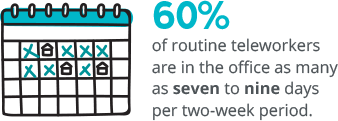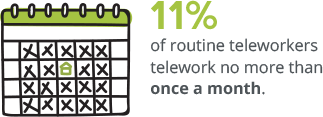Report
Managing your mobile workforce when teleworkers return

The best telework programs help employees work effectively from home—but also offer the right mobile work environments when they are back in the office.
A key component of telework programs is establishing mobile workforce environments that support telework-eligible employees when they are in the office. This includes federal agencies implementing “hoteling” systems for office seating, adopting open floorplans, and more.
Agencies plan for the mobile work transformation and they implement workplace changes that reshape workplace culture. But what about sustaining mobile workforce environment success in the long run?
Successful mobile workforce environments require a long-term vision and an action plan to help teleworkers and their managers implement mobile work policies while teleworking and at the office. This is how agencies get the best of both worlds—lowered costs and reduced footprints with higher productivity and employee satisfaction.


United States Office of Personnel Management (Fiscal Year 2016). Status of Telework in the Federal Government Report to Congress.
The building blocks to sustain a mobile workforce environment

Mindset
Think differently to work differently
Breaking away from a “this-is-how-it-has-always-been-done” mindset when planning, implementing, and improving mobile workforce environments is key to maximizing mobile work benefits.
- Resist the temptation to simply replicate traditional office processes in a mobile environment.
- Think beyond a sterile environment; infuse the spirit of the mission into the physical space.
- Be open to creating new roles, shifting old ones, and getting creative to optimize resource use.
- Support ways of working so employees feel connected to a sense of purpose and community.

Strategy
Look to the future from the start
Developing a thoughtful strategy that addresses all of the complexity and nuance of rolling out—and sustaining—a mobile workforce environment is key to move from reactive to proactive approaches.
- Account for budget requirements needed to sustain the mobile environment, like IT refreshes.
- Develop standard contract management approaches from the outset to avoid redundancies.
- Take advantage of best practices and economies of scale by planning now for broader roll-outs.
- Ensure the strategy does not overlook the people and change aspects of this shift in working.

Process
Eliminate the confusion of the unknown
Recognizing that old office management approaches no longer apply and ensuring new ones are clear and well-defined is key to engage employees and create a productive mobile workforce environment.
- Develop processes for the how-tos of everyday work—from reserving space to getting supplies.
- Ensure employees know what to do with their laptops and how to get loaner equipment if needed.
- Implement, document, and codify processes into standard policy for all mobile environments.
- Develop an onboarding plan for new hires so they are comfortable with processes and policies.

Communication
Get everyone on the same page
Prioritizing transparency and communication at all times is key to building employees’ confidence and comfort in the mobile workforce environment and eliminating surprises that cause frustration.
- Determine who all the stakeholders are: employees, supervisors, and executive sponsors.
- Create multi-format quick guides and help-desk support to answer employee issues and questions.
- Use digital/mobile channels for training and communicating ongoing operational changes.
- Clean distribution lists so that communications actually go to those in the mobile environment.

Consistency
Avoid reinventing the wheel
Industrializing processes and operations across multiple mobile workforce environments can create economies of scale, lower costs, and improve efficiency and productivity.
- Replicate the best of what is working in the pilot location in other mobile environments.
- Make things easier for employees who work in multiple locations with standard business rules.
- Apply solutions developed in one location to avoid the same problem in other locations.
- Create a project management office to oversee all locations and build efficiency and scale.

Measurement
Know what success looks like
Assessing program performance from the beginning helps to accurately measure success of the program, promotes successful mobile work policy adoption, and offers opportunity to adjust course if needed.
- Account for new expenses to get a true picture of total cost savings from the mobile environment.
- Continually assess space needs, capacity, and utilization.
- Maximize telework agreements by identifying what days people are in the office.
- Do not discount the value of “soft” metrics—develop ways to track if the workforce is happier.

Connection
Listen and learn to improve
Avoiding planning and implementing in a vacuum is critical to ensure that the mobile workforce environment reflects the needs and behaviors of all stakeholders as well as leading practices.
- Conduct quarterly reviews with stakeholders of the success of the mobile workforce environment.
- Solicit employee feedback and use a closed-loop process to act on meaningful improvements.
- Host listening sessions for employees who are not inclined to participate in a written survey.
- Tour other organizations’ mobile workspaces for insights into what works and what doesn’t.

Evolution
Plan for change, change the plan
Trading linear approaches (that do not account for change) for iterative ones (that do) is key to keep mobile workforce environments working well as technology and other external factors evolve.
- Prepare for fluidity and flexibility to be the new normal—change is change, and it will happen.
- Stay on top of changing requirements and do not wait to determine what the impacts will be.
- Prioritize change management across training, communications, and among change agents.
- Test and refine new ideas through pilots that minimize investment and create buzz from the start.

